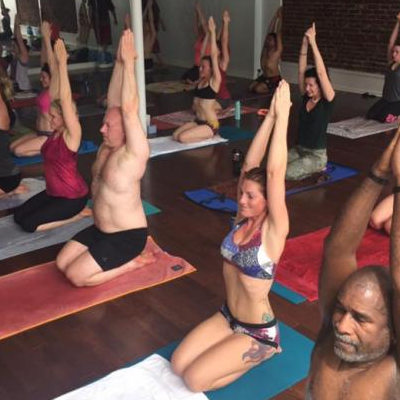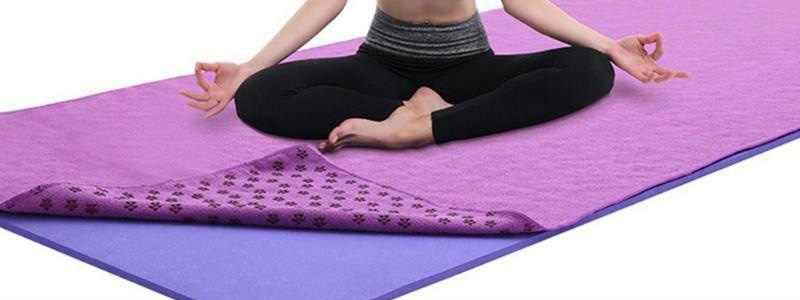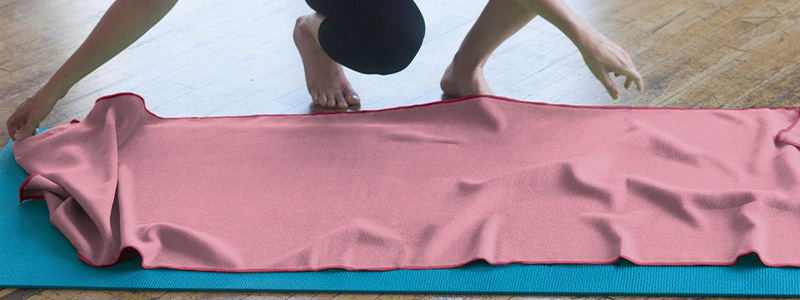Table of Contents
1.Introduction

Yoga is a great way to improve your physical and mental health. It is a low-impact exercise that can help you build strength, flexibility, and balance. However, if you have ever practiced yoga, you know that sweating and slipping can be a real problem. That’s where yoga towels come in. In this article, we will discuss everything you should know about yoga towels.
2.What is yoga towel?
A yoga towel is a type of specialized towel that is designed to provide better grip, absorb sweat, and prevent slips during yoga practice. It is typically made of a soft, absorbent material, such as microfiber, that helps to wick away moisture from the body and the yoga mat.
Yoga towels come in various sizes and shapes to fit different yoga mats and personal preferences. Some are rectangular and designed to cover the entire yoga mat, while others are smaller and used to cover just a portion of the mat, such as the area where the hands and feet are placed during yoga poses.
3.What is the difference between yoga towel and yoga mat?
Many people may mix the yoga towels with yoga mats due to some similar features like appearances and usages. So now follow Speck to take a look at the differences between the yoga towel and yoga mat!
Function
- The primary function of a yoga mat is to provide a stable, cushioned surface for yoga practice. It helps to prevent slipping and provides support for various poses.
- A yoga towel, on the other hand, is primarily used to absorb sweat and provide additional grip on top of a yoga mat.
Material
- Yoga mats are typically made of rubber, PVC, or other synthetic materials that provide a non-slip surface.
- Yoga towels are often made of microfiber or cotton, which are highly absorbent and help to wick away moisture from the body.
Size and shape
- Yoga mats come in various sizes and shapes, but they are generally rectangular and larger than yoga towels.
- Yoga towels can be rectangular, but they are also available in smaller sizes that are designed to fit just over the area where the hands and feet are placed during yoga poses.
Portability
- Yoga mats can be rolled up and carried with a strap or placed in a yoga bag for easy transport.
- Yoga towels are typically lighter and more portable, as they can be easily folded or rolled up and placed in a bag or carried on their own.
Cost
- Yoga mats tend to be more expensive than yoga towels, as they are often made of higher quality materials and are designed to last longer.
- Yoga towels are more affordable and can be easily replaced when needed.
4.What are the types of Yoga Towels?
Types of yoga towels vary from their functions and the following are some yoga towels commonly seen on the market.
- Standard Yoga Towel: This is the most common type of yoga towel, designed to fit over a standard yoga mat. It provides a non-slip surface for hands and feet, and can also be used to absorb sweat during practice.

- Hot Yoga Towel: Hot yoga towels are designed for use in hot yoga and Bikram yoga classes, where the room temperature is typically kept at around 100 degrees Fahrenheit. These towels are typically made from materials like microfiber and have added grip features to prevent slipping on a sweaty mat.

- Hand Towel: Hand towels are smaller than standard yoga towels and are designed for use primarily as a sweat-absorbing accessory. They can be used to wipe sweat from the face and body during practice, or to provide extra grip when folded over a yoga mat.

- Travel Yoga Towel: Travel yoga towels are lightweight and compact, designed for easy packing and transport. They can be used as a mat towel or as a quick-drying towel for showering after practice.

- Combo Yoga Mat/Towel: Combo yoga mats/towels are a newer type of product that combine the functions of a yoga mat and towel into one. They typically have a microfiber towel surface bonded to a natural rubber base, providing both absorbency and traction.
5.What are the pros of yoga towels?

- Sweat Absorption: Yoga towels are designed to absorb sweat, which can help prevent you from slipping and sliding on your mat during practice. This can improve your grip and stability in poses, making it easier to hold them for longer periods of time.
- Hygiene: Yoga towels are easy to clean and can help keep your yoga mat clean and free of bacteria and germs. This can be especially important if you practice hot yoga or frequently use your mat in public spaces.
- Portability: Many yoga towels are lightweight and easy to pack, making them a great accessory for travel or outdoor yoga practices. Some towels are specifically designed for travel and come with their own carrying cases.
- Comfort: Yoga towels can provide extra cushioning and support, especially if you are practicing on a hard or uncomfortable surface. They can also help reduce pressure on your joints during certain poses.
- Versatility: Yoga towels can be used in a variety of ways, such as for sweat absorption, as a cushion, or as a prop to help you deepen your stretches. Some towels are also designed to be used as a beach or picnic blanket, making them a versatile accessory for outdoor activities.
6.What are the cons of yoga towels?
While selecting products, their disadvantages also can’t be ignored. Yoga towels also have some downsides needing our attention.One of the biggest disadvantage of yoga towels is the additional expense they represent. High-quality yoga towels can be expensive, and if you’re on a tight budget, it may be difficult to justify the expense.
Additionally, yoga towels require regular washing to keep them clean and free of bacteria and germs, which can be time-consuming and may require additional expenses for laundry detergent and water. Some yoga towels are also made from synthetic materials, which may not be environmentally sustainable, and they may not fit properly on certain types of yoga mats, which can negatively impact your practice. Overall, while yoga towels offer many benefits, it’s important to consider these potential downsides before making a decision about whether to use one.
7.What materials are yoga towels made from?

Yoga towels can be made from a variety of materials, but some common ones include:
- Microfiber: This is a popular material for yoga towels as it is lightweight, absorbent, and quick-drying. Microfiber towels are also durable and can withstand multiple washings.
- Cotton: Cotton towels are soft and comfortable, and many people prefer them for yoga practice. They are also absorbent, but may take longer to dry than microfiber towels.
- Bamboo: Bamboo towels are eco-friendly and sustainable. They are naturally anti-bacterial and anti-microbial, which makes them a good choice for yoga practice.
- Hemp: Hemp towels are also eco-friendly and sustainable, and they are known for their durability and strength. They are also naturally anti-bacterial and anti-microbial.
- TPE (Thermoplastic Elastomer): TPE towels are made from a blend of plastic and rubber, and are designed to provide extra grip during yoga practice. They are also easy to clean and quick-drying.
8.What are the sizes of Yoga Towels?

When you look for a yoga towel on the market, you may be dazzled by yoga towels of different sizes and thicknesses, not knowing which one to choose. As a leading custom yoga towel manufacturer, Speck will present some common sizes and thicknesses of yoga towels:
- Standard size: This is the most common size of yoga towel and is typically around 24 x 68 inches. It is suitable for most yoga mats and is easy to carry around. Standard size towels can range in thickness from lightweight to thick, depending on the material.
- Extra large size: These towels are larger than standard towels and are typically around 30 x 72 inches. They provide more coverage and can be useful for people who want to use them for full-body yoga practice or for hot yoga.
- Travel size: Travel-sized yoga towels are smaller than standard towels and are typically around 20 x 30 inches. They are compact and easy to pack, making them ideal for people who want to practice yoga while on the go.
9.What are the benefits of Using a Yoga Towel?

- Improved Grip:A yoga towel can offer extra grip and traction, which can help you maintain stability and prevent slipping during your practice.
- Increased Stability: The added layer of the towel can provide additional stability, especially when practicing challenging poses that require balance and strength.
- Increased Balance:With its non-slip properties, a yoga towel can help improve your balance and prevent you from sliding or losing your footing during your practice.
- Added Cushioning:A yoga towel can provide extra cushioning and support for your joints, making your practice more comfortable and preventing injuries.
- Keeping Mats Clean:A yoga towel can protect your yoga mat from dirt, sweat, and bacteria, keeping it clean and hygienic for your next practice.
- Reducing Sweat Deterioration:The absorbent properties of a yoga towel can help prevent sweat from saturating and deteriorating your yoga mat, making it last longer.
- Reducing Friction Deterioration: A yoga towel can help reduce the friction between your body and the mat, preventing deterioration and extending the life of your mat.
- A More Sanitary Practice:Using a yoga towel can create a barrier between your body and the mat, preventing the spread of germs and bacteria.
- Easy to Wash:Yoga towels are easy to wash and dry, making them a convenient and practical accessory for your yoga practice.
- Can Replace Mats:In some cases, a yoga towel can be used as a substitute for a yoga mat, especially when traveling or practicing in a location where mats are not available.
- Travel-Friendly: Yoga towels are lightweight, compact, and easy to pack, making them an ideal accessory for traveling yogis.
10.How to Use a Yoga Towel?

Some people who had bad using experience may question the benefits of yoga towels. Here Speck guesses that they haven’t taken right steps to use a yoga towel. So knowing how to use a yoga towel is also important before you get one.
- Place the towel on top of your yoga mat: Start by laying the yoga towel on top of your yoga mat, making sure it is centered and aligned with the mat.
- Smooth out any wrinkles: Smooth out any wrinkles or creases on the towel to ensure a flat and even surface.
- Secure the towel to the mat: If the towel has corner pockets or straps, secure it to the mat to prevent it from slipping or sliding during your practice.
- Use the towel for grip and stability: During your practice, use the towel for added grip and stability, especially in poses that require a strong foundation or balance.
- Wipe away sweat: If you sweat during your practice, use the towel to wipe away sweat from your face, hands, and body.
- Fold or roll the towel for additional cushioning: If you need extra cushioning for your joints, fold or roll the towel and place it under your knees, elbows, or hips.
- Clean and store the towel: After your practice, clean the towel according to the manufacturer’s instructions and store it in a dry and cool place.
11.How to maintain Yoga Towels in right way?
To maintain your yoga towels in the right way and extend their lifespan, here are some tips to follow:
- Wash your yoga towels regularly: Depending on how often you use your yoga towels, you may need to wash them after every use or every few uses. Follow the manufacturer’s instructions for washing, but typically you can machine wash them with like colors using mild detergent, then air dry or tumble dry on low heat.
- Avoid using fabric softeners: Fabric softeners can leave a residue on your yoga towels and make them less absorbent. Instead, add a cup of white vinegar to the wash to help remove any buildup.
- Keep them away from direct sunlight: Sunlight can cause the color of your yoga towels to fade and weaken the fibers. Store them in a cool and dry place, away from direct sunlight.
- Avoid using bleach: Bleach can damage the fibers and cause discoloration. Instead, use an oxygen-based cleaner if you need to whiten your towels.
- Replace when necessary: If your yoga towels become thin, worn out, or lose their grip, it may be time to replace them to maintain the benefits of using a yoga towel.
By following these simple tips, you can keep your yoga towels in good condition and ensure they continue to provide you with the benefits you need during your yoga practice.
Conclusion
Good tools are essential. Speck’s wholesale custom yoga towels are designed with the needs of yogis in mind, and are made from top-quality materials to ensure they stand up to the rigors of your practice.
Besides, Speck yoga towels are available in a variety of colors and styles to suit your individual preferences, and are designed to provide superior grip and absorbency. Whether you’re practicing hot yoga, power yoga, or any other type of yoga, our towels are the perfect addition to your practice.
Want to purchase custom yoga towels in bulk? You are welcome to write to us: sales@yogafitness.group







